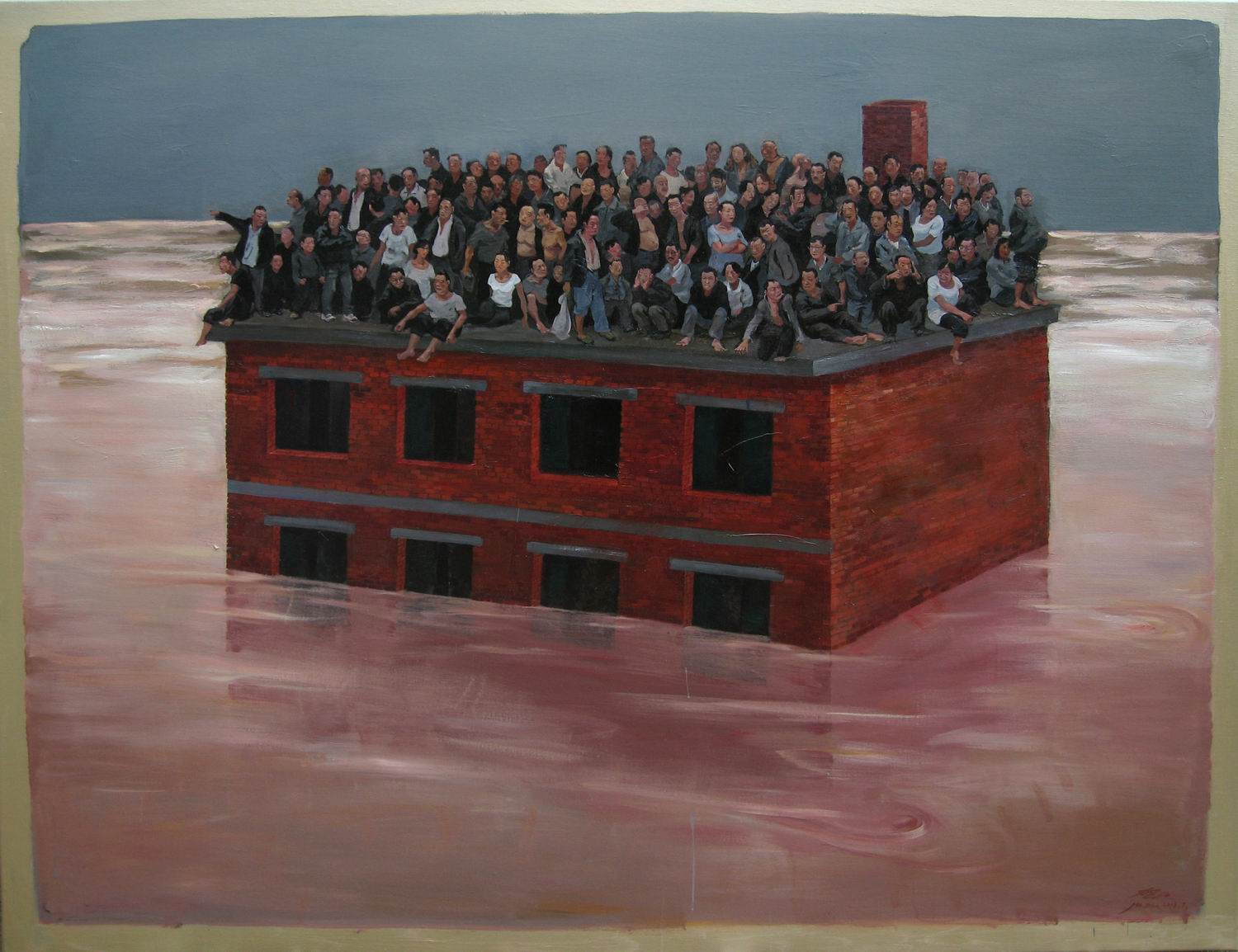评论观点
Comment
超然局外并深陷其中——贺丹画卷中的张力
发布时间:2021-03-05

文:杜曦云
1992年,是中国社会迅速转型具有标志性的年份。和计划经济模式相区别的市场经济,开始步履稳定的落地、蔓延,直至渗透到中国大陆的边边角角。如今已成事实的很多全球化成果,溯源时也归根到那个年份。
贺丹延续至今的油画图卷,也是从那个年份开始浮出水面,例如1992年的《驴市》。有趣的是,从他那些画卷中来看,他的目光所聚,是中国西北经济欠发达地区的众生。因为地处内陆深处,市场经济以及它所带来的方方面面的改变,似乎尚未波及到这方水土这方人,他们依然故我的休养生息着,上演一出出自成一体的喜怒哀乐,在贺丹透过自己的心理滤镜所生成的油彩镜像中,以黯淡荒凉的色调呈现着。
贺丹1990年代早期的这些绘画,应该主要是画家本能观看的产物。在游走或驻地时,尊重自己真实感受的人,会自然的把自身基本情感作为综合判断的出发点。从贺丹这个阶段的画面来推测,贺丹当时油然而生的情怀,以悲悯为主。艺术表达对他而言,应该是靠近自己体会到的真相,而不是按照他人的指令来粉饰或歌颂。这种艺术观能让艺术表达自然生成一番面貌来,和风俗画的气息自然区分开来。直到今天,以西北为题材的大多数绘画和摄影等,依然在推销着西北风俗、风情……
从1990年代中期开始,贺丹在巴黎生活十余年,然后再回到中国至今。人是生存处境的产物、文化的容器,生存处境和知识结构的改变等,体现在贺丹的绘画上,首先是视角的改变。对中国西北经济欠发达地区人群的关注是起点,继而延伸到表达更多地区、阶层人们的样态。更明显的变化是:文化自觉所导致的观念清晰,刷新了以前朴素的基本情感。当然,基本情感,始终是文化的起点和终点;观念清晰,是以具有视觉感染力的美学方式表达出来的。从这些绘画中可以看到,即使有些作品依然表达西北经济欠发达地区的人群,但透露出的画家本人的文化视野、问题意识等,已经是当代知识分子的风范了。
这些直面视网膜的画卷,通过视觉语言来传达出的意蕴,是含混多义、五味杂成的。局部的细节相当真实,整体结构却是象征性的虚构。造型、色彩和用笔,貌似朴拙雕凿,其实轻松挥写,透露出不假思索的个性。如果说早期绘画有勃鲁盖尔的痕迹,这些年来的作品则更加放松,在信马由缰的发挥中自成面貌。
贺丹近年来的作品,无论是各色的“蚂蚁”、“蜜蜂”,还是《大飞机》、《长途车》、《苹果》、《洪水》等,所指虽然各有不同,但总是一个个群体的运动状态。在这种凸显群体的画卷中,个体是被弱化的。其中,和群体保持距离的个体很少见,特立独行的更是稀有。身处其中的渺小个体们,看上去各怀心思,而且复杂莫测;但统观时,又是相当趋同的。那一张张脸孔、一个个身姿中所显现的欲望,清晰并混沌、明确而茫然,仿佛被难解的宿命笼罩。
多年来反复围绕这些人群、这批主题孜孜涂绘的画家本人,也仿佛被莫名其妙的咒语所施:一方面旁观这些人群局面,拥有置身事外的视角;另一方面,他自己也是深陷在这人群中的一员,难以自拔并困惑无措。仔细观察这些人头攒动的画卷时,不难发现:画家时常把自己画入人群中,神情动作各不相同。
贺丹反复涂绘的这些密集群体,因为个体的特点被弱化,容易被人当作无足轻重的背景。其实,每一位个体的能量都无法抹煞,貌不惊人的大多数,往往才是深重影响局势的主体。越是对历史变迁、文明更迭有所意识的旁观者,越容易对这些画卷的意蕴应目会心。如果是身在群体中的人有所感应,或许会一时语塞,默视无言。在不同的时代氛围里,各种可能性的发酵状况是不同的,未来的图卷中,贺丹所关注的群体会涂绘成什么形色样态?
2019年6月23日于广州

Independence and deep into—the tension in the He Dan’s painting
Written by Du Xiyun
1992 was a landmark year for the rapid transformation of Chinese society. The market economy, which is different from the state controlled and planned economy model, had begun to develop and spread steadily until it penetrated every corner of mainland China. Nowadays, many results of globalization in contemporary China can be traced back to that year.
The oil paintings that He Dan continued to create started to surface that very year as well, for example the "Donkey Market" in 1992. Interestingly, composing the painting, he concentrated on people in the economically underdeveloped areas of Northwest China. Because this area is located in the depths of the hinterland, the market economy with all the changes it had brought did not seem to have a strong effect to this side of the country. People there still lived their own rhythems and played all the joys and sorrows of daily life on a stage they seemed to write and direct by themselves. The oil painting created by He Dan through his personal psychological filter presented this state of being in a gloomy way and desolately.
He Dan's paintings in the early 1990s can be mainly seen as the product of the artist's instinct to watch. When he wandered around or stayed somewhere in residency, native and rather simple minded people would naturally use their basic emotions as starting point for a comprehensive interpretation. There is a general speculation that He Dan’s painting at this stage, were strongly influenced by He Dan’s feelings of sympathy and compassion. For him, artistic expression should represent a truth close to his own experience, rather than boosting reality with eulogies according to the instructions of others. This kind of artistic view made up his artistic expression in a natural way, and separated it in a natural way from genre painting. Until today, most of the paintings and photography on the northwest are still selling to local customers and their landscape of the northwest...
From the mid-1990s, He Dan lived in Paris for more than ten years before returning to China. Man as the primary object of his painting is the result of his living situation, man seen as the container of culture and the carrier of the embodied structure of knowledge, etc. In He Dan's paintings, first of all, there is the aim of a change of perspective with its focus on the underdeveloped areas of Northwest China as a starting point of his artwork. And in turn it extends to the expression of the living situation of more people belonging to the same social class within this region. A more obvious change in the work of He Dan is that he is addressing the clear concept of cultural self-consciousness and the returning to a refreshed take on basic emotions of the past. Of course, basic emotions of people are always at the beginning and ending points of culture. The concept of expression is clear in a visually appealing aesthetic. It can be seen from these paintings that even though some works still deal with the people in the economically underdeveloped areas of the northwest, the cultural vision and problem awareness of the painter himself are already close to the style of contemporary intellectuals.
These pictures are conceived and conveyed through visual language. They are vague, polysemy and ambiguous. The partial details are quite real, but the overall structure is of a symbolic fiction. Shape, colour and the way of painting and composing are seemingly simple and in a naturalistic style, but actually set in a very freehanded way and reveal their personality immediately. If we say his early paintings carry traces of Bruegel, his latter works of these years are more unbound and forming their own style in great freedom.
Recently, we find in He Dan's works, no matter if conceived as a variety of "ant", "bee", or "big plane", "long-distance car", "Apple", "flood", etc., that in total they are part of a group movement, although the meaning and metaphorical language are different,. In the paintings of this prominent group, the appearance of the individual is weakened. Among them, individuals who keep a distance from the group and mavericks are rare. The small amount of individuals who is in it seems hypocritical and unpredictable. But then again they are quite similar in the birds view. The desires appearing in the faces and the postures are clear; chaotic and stunned, as if they were shrouded in inextricable fate.
Over the years, the artist has repeatedly painted crowds and its related topics. He seems to have been cursed inexplicably. On the one hand, he observed the situation of these people having an external perspective. On the other hand, he also was deeply trapped in this and became one of them and kept on in extricating and confusing ways. When you look closely at these pictures, it is not difficult to find out, that the artist often positioned himself into the crowd and has a different look.
These dense groups that He Dan repeatedly painted are easily regarded as insignificant part of the social, because the features of individuals in the crowd are easily undergoing deindividualization. But in fact, the influence of each individual cannot be erased. Actually, it is mostly the people who are not surprisingly often the main power that deeply influences history. The more the observer is being aware of historical changes and transformation in social realms, the easier it is to understand the meaning of these painting scrolls. If a person being part of the crowd fell for his future, this person might have kept silent and ignorant. In different epochs of history, the conditions of artistic expression within a range of various possibilities were different. In future group paintings, what kind of forms will be He Dan's concern?
Guangzhou, June 23, 2019